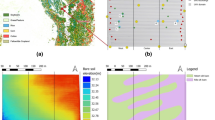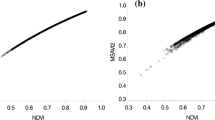Abstract
Soil acidification is a growing problem in semi-arid agroecosystems. In the state of Montana, USA, soil pH levels below 5.5 have been documented in nearly half of the counties. Acidic soils have the potential to reduce crop yield, but methods to identify and remediate acidic soils are costly and time-intensive. This study tests a relatively new approach for identifying areas of acidic soils using imagery derived from UAS (unmanned aerial systems). UAS provide a means to collect fine-scale, multi-spectral imagery at user-defined intervals for an area of interest—in this case, a 22 ha spring wheat field in southwestern Montana. In addition to 12 dates of spectral observations across a growing season, field measurements of soil pH and other soil attributes were collected to analyze their relationship with the normalized difference vegetation index (NDVI) using linear regression models, and to spatially predict soil pH across the field using a random forest model. The linear regression models indicated that most of the variation in early-season NDVI was attributed to differences in soil pH and soil organic matter, whereas variation in later-season NDVI was less related to soil pH. The random forest model predicted soil pH with reasonable accuracy (RMSE = 0.72). This study helps to fill a knowledge gap by bridging UAS-derived observations of NDVI with field-derived measurements of soil pH to identify areas of soil acidity. The methodology put forth by this study would enable land managers to easily identify and hence, remediate acidic soils in a more cost-efficient and timely manner.






Similar content being viewed by others
Availability of data and material
Can be given upon request.
References
Barber, S. A. (1984). Liming materials and practices. In Soil acidity and liming (pp. 171–209). American Society of Agronomy Inc.
Bartoń, K. (2020). MuMIn: Multi-Model Interference. (version 1.43.17): CRAN-R. Retrieved April 1, 2021, from https://cran.r-project.org/web/packages/MuMIn/MuMIn.pdf.
Beyer, H. L. (2004). Hawth’s Analysis Tools for ArcGIS. Geospatial modelling environment: Spatial ecology. Retrieved April 1, 2021 from http://www.spatialecology.com/gme/.
Bolan, N. S., Adriano, D. C., & Curtin, D. (2003). Soil acidification and liming interactions with nutrient and heavy metal transformation and bioavailability. Advances in Agronomy, 78, 215–272. https://doi.org/10.1016/S0065-2113(02)78006-1.
Borgelt, S. C., Searcy, S. W., Stout, B. A., & Mulla, D. J. (1994). Spatially variable liming rates: A method for determination. Transactions of the American Society of Agricultural Engineers, 37(5), 1499–1507. https://doi.org/10.13031/2013.28233.
Gazey, P. (2020). Soil acidity. Retrieved September 16, 2020, from http://soilquality.org.au/factsheets/soil-acidity.
Ghimire, R., & Machado, S. (2017). Soil acidity limits wheat yield in dryland regions of the Inland Pacific Northwest. Crops & Soils, 50(2), 14–16. https://doi.org/10.2134/cs2017.50.0213.
Goulding, K. W. T. (2016). Soil acidification and the importance of liming agricultural soils with particular reference to the United Kingdom. Soil Use and Management, 32(3), 390–399. https://doi.org/10.1111/sum.12270.
Havlin, J. L., Tisdale, S. L., Nelson, W. L., & Beaton, J. D. (2013). Soil fertility and fertilizers (8th ed.). Macmillan.
Huang, Y., Thomson, S. J., Hoffmann, C., Lan, Y., & Fritz, B. K. (2013). Development and prospect of unmanned aerial vehicle technologies for agricultural production management. International Journal of Agricultural and Biological Engineering, 6(3), 1–10. https://doi.org/10.3965/j.ijabe.20130603.001.
Ihaka, R., & Gentleman, R. R. (2012) A language and environment for statistical computing. In R. D. C. Team (Ed.), (R 3.6.2 ed.). University of Auckland, R Foundation for Statistical Computing.
Johnston, A. E. (2004). Soil acidity—Resilience and thresholds. In B. T. Christensen, P. Schjonning, & S. Elmholt (Eds.), Managing soil quality: Challenges in modern agriculture (pp. 35–46). CABI Publishing.
Jones, C., Engel, R., Ewing, S., Miller, P., Olson-Rutz, K., & Powell, S. (2019a). Soil acidification: An emerging problem in MT. In Jones & Olson-Rutz (Eds.), Montana fertilizer eFacts. MSU Extension, Montana State University.
Jones, C., Engel, R., & Olson-Rutz, K. (2019b). Soil acidification in the semiarid regions of North America’s Great Plains. Crops & Soils, 52(2), 28–56. https://doi.org/10.2134/cs2019.52.0211.
Liaw, A., & Wiener, M. (2002). Classification and Regression by randomForest. R News, 2(3), 18–22.
Liu, H., Zhu, H., & Wang, P. (2017). Quantitative modelling for leaf nitrogen content of winter wheat using UAV-based hyperspectral data. International Journal of Remote Sensing: Unmanned aerial vehicles for environmental applications, 38(8–10), 2117–2134. https://doi.org/10.1080/01431161.2016.1253899.
Mengmeng, D., Noboru, N., Atsushi, I., & Yukinori, S. (2017). Multi-temporal monitoring of wheat growth by using images from satellite and unmanned aerial vehicle. International Journal of Agricultural and Biological Engineering, 10(5), 1–13. https://doi.org/10.25165/j.ijabe.20171005.3180.
Mulla, D. J. (2013). Twenty five years of remote sensing in precision agriculture: Key advances and remaining knowledge gaps. Biosystems Engineering, 114(4), 358–371. https://doi.org/10.1016/j.biosystemseng.2012.08.009.
Pearson, R. W., & Adams, F. (1967). Soil acidity and liming. American Society of Agronomy.
PRISM. (2020). 30-Year normals. Retrieved April 1, 2021, from https://prism.oregonstate.edu/normals/.
Slessarev, E. W., Lin, Y., Bingham, N. L., Johnson, J. E., Dai, Y., Schimel, J. P., et al. (2016). Water balance creates a threshold in soil pH at the global scale. Nature, 540, 567–569. https://doi.org/10.1038/nature20139.
Smith, D. (2004). Dial in soil pH. Farm Journal Magazine. Retrieved April 1, 2021, from http://www.valleyviewindustries.com/article.htm.
Soil Survey Staff. (ND). Natural Resources Conservation Service, United States Department of Agriculture. Official Soil Series Descriptions. Retrieved April 1, 2021, from https://www.nrcs.usda.gov/wps/portal/nrcs/detail/soils/survey/geo/?cid=nrcs142p2_053587.
Tohry, A., Chehreh Chelgani, S., Matin, S. S., & Noormohammadi, M. (2020). Power-draw prediction by random forest based on operating parameters for an industrial ball mill. Advanced Powder Technology, 31(3), 967–972. https://doi.org/10.1016/j.apt.2019.12.012.
Torres-Sánchez, J., Peña, J. M., de Castro, A. I., & López-Granados, F. (2014). Multi-temporal mapping of the vegetation fraction in early-season wheat fields using images from UAV. Computers and Electronics in Agriculture, 103, 104–113. https://doi.org/10.1016/j.compag.2014.02.009.
Uddin, M. A., Mansour, A., Jeune, D. L., Ayaz, M., & Aggoune, E.-H. M. (2018). UAV-assisted dynamic clustering of wireless sensor networks for crop health monitoring. Sensors, 18(2), 555. https://doi.org/10.3390/s18020555.
Weiss, M., Jacob, F., & Duveiller, G. (2020). Remote sensing for agricultural applications: A meta-review. Remote Sensing of Environment, 236, 111402. https://doi.org/10.1016/j.rse.2019.111402.
Yue, J., Li, C., & Zhu, J. (2012). The application of unmanned aerial vehicle remote sensing in quickly monitoring crop pests. Intelligent Automation and Soft Computing, 18(8), 1043–1052. https://doi.org/10.1080/10798587.2008.10643309.
Zhang, C., & Kovacs, J. M. (2012). The application of small unmanned aerial systems for precision agriculture: A review. Precision Agriculture, 13, 693–712. https://doi.org/10.1007/s11119-012-9274-5.
Zheng, H., Cheng, T., Li, D., Yao, X., Tian, Y., Cao, W., & Zhu, Y. (2018). Combining Unmanned Aerial Vehicle (UAV)-based multispectral imagery and ground-based hyperspectral data for plant nitrogen concentration estimation in rice. Frontiers in Plant Science, 9, 936. https://doi.org/10.3389/fpls.2018.00936.
Acknowledgements
This study received financial support from the Montana Wheat and Barley Committee, the Montana Agricultural Experiment Station, USDA-National Institute for Food and Agriculture, AmericaView (through U.S. Geological Survey grant/cooperative agreement no. G18AP00077), and the Western Sustainable Agriculture Research and Education. The authors would like to thank the following individuals for their generous help and support during the research: Rick Engel, Patrick Ewing, Mary Farina, Dale Flikkema, Dave Gettel, Bruce Maxwell, Perry Miller, Jeff Nesbitt, Paul Stoy, Rachel Ulrich, Rosie Wallander, and Russ Westlake. We would also like to acknowledge two anonymous reviewer and Editor comments for helping to improve the manuscript.
Author information
Authors and Affiliations
Corresponding author
Ethics declarations
Conflict of interest
All authors declare that they have no conflict of interest.
Code availability
Can be given upon request.
Ethical approval
This study received financial support from the Montana Wheat and Barley Committee, the Montana Agricultural Experiment Station, USDA-National Institute for Food and Agriculture, AmericaView, and the Western Sustainable Agriculture Research and Education.
Additional information
Publisher's Note
Springer Nature remains neutral with regard to jurisdictional claims in published maps and institutional affiliations.
Rights and permissions
About this article
Cite this article
Webb, H., Barnes, N., Powell, S. et al. Does drone remote sensing accurately estimate soil pH in a spring wheat field in southwest Montana?. Precision Agric 22, 1803–1815 (2021). https://doi.org/10.1007/s11119-021-09812-z
Accepted:
Published:
Issue Date:
DOI: https://doi.org/10.1007/s11119-021-09812-z




